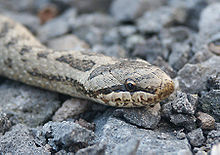Smooth snake
| Coronella austriaca | |
|---|---|

| |
| Scientific classification | |
| Kingdom: | |
| Phylum: | |
| Class: | |
| Order: | |
| Suborder: | |
| Family: | |
| Subfamily: | |
| Genus: | |
| Species: | C. austriaca
|
| Binomial name | |
| Coronella austriaca | |
Common names: Smooth snake.[2]
Coronella austriaca is a harmless colubrid species found in northern and central Europe, but also as far east as northern Iran. The EMBL currently recognizes three subspecies, including the typical form described here.[1]
Description
Both sexes grow to an average length of about 50 cm. Two specimens measuring 83 cm have been recorded in Sweden, as well as one in Russia that was 92 cm.[2]
The head has a rostral scale that is at least as deep as it is wide, creating a triangular indentation between the internasals (rarely separating them). The top of the head is covered with 9 large plates. The nasal scale is often divided. There is 1 (rarely 2) preoculars and 2 postoculars. The temporals number 2+2 (rarely 1+2) or 2+3. There are 7 (rarely 8) upper labials, of which the 3rd and 4th or 4th and 5th border the eye.[2]
Midbody there are 19 (rarely 17 or 21) rows of smooth dorsal scales. The ventrals number 150-164 in male4s and 162-200 in females. The anal scale is divided (rarely single) and the subcaudals paired. Males have 54-70 subcaudals and females 40-76.[2]
The color pattern consists of a brown, grey of reddish ground color[3] with two rows of small, rather indistinct dark spots running down the back towards the tail. In some cases, each pair of spots may be united towards the neck area, forming a series of cross-bars over the back. There is also a very indistinct series of dark spots running along each of the flanks. These four series of spots that run the length of the body overlay four parallel, rather shadowy stripes that also run down the back and flanks.[2]
Dorsally, the head has somewhat heart-shaped making that resembles an inverted V posteriorly. This shape is where the name Coronella comes from, which means coronet (a small crown). A relatively thick dark stripe extends from the nostril along the side of the head to a little beyond the neck, only being interrupted by the eye. The upper labials are whitish, grayish-white or light brown, sometimes with darker spots. The tongue is reddish brown or dark red.[2]
Geographic range
Found from the south of England through France and the Low Countries to northern Spain and Portugal, Germany, Denmark, Norway and Sweden (as far north as 63° latitude), Switzerland, Austria, Italy and Sicily (but not in Corsica or Sardinia), the western Balkans and Greece, and European Russia as far north as 57° latitude. In Asia, it is found from Turkey to Azerbaijan, Georgia (country), Armenia and northern Iran.[3]
Subspecies
| Subspecies[1] | Authority[1] | Geographic range |
|---|---|---|
| C. a. austriaca | Laurenti, 1768 | |
| C. a. acutirostris | Malkmus, 1995 | |
| C. a. fitzingeri | Bonaparte, 1840 | Southern Italy and Sicily.[2] |
Cited references
- ^ a b c d Species Coronella austriaca at The Reptile Database
- ^ a b c d e f g Street D. 1979. The Reptiles of Northern and Central Europe. London: B.T. Batsford Ltd. 268 pp. ISBN 0-7134-1374-3.
- ^ a b Steward JW. 1971. The Snakes of Europe. Cranbury, New Jersey: Associated University Press (Fairleigh Dickinson University Press). 238 pp. LCCCN 77-163307. ISBN 0-8386-1023-4.
Gallery
-
C. austriaca in Bosnia and Herzegovina.
-
C. austriaca.
External links
- Coronella austriaca at Amphibians and Reptiles of Europe. Accessed 7 October 2006.
- Smooth snake (Coronella austriaca) at ARKive. Accessed 7 October 2006.
- Smooth Snake - Coronella austriaca at Reptiles and Amphibians of the UK. Accessed 7 October 2006.
- Smooth snake, Coronella austriaca at Reptiles & Amphibians of France. Accessed 30 October 2006.
- Coronella austriaca at Checklist of Armenia's Amphibians and Reptiles, Tadevosyan's Herpetological Resources. Accessed 30 March 2007.

